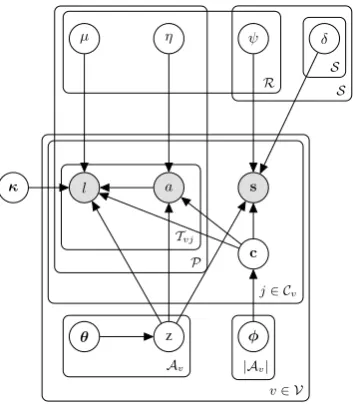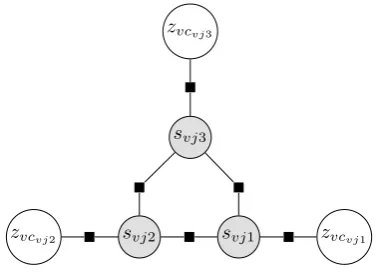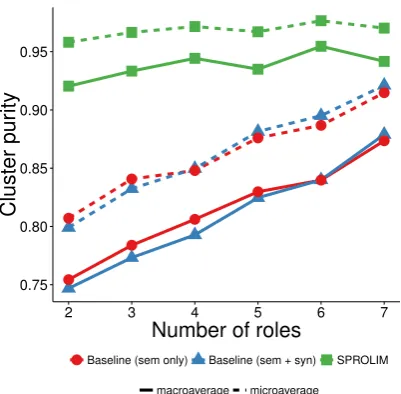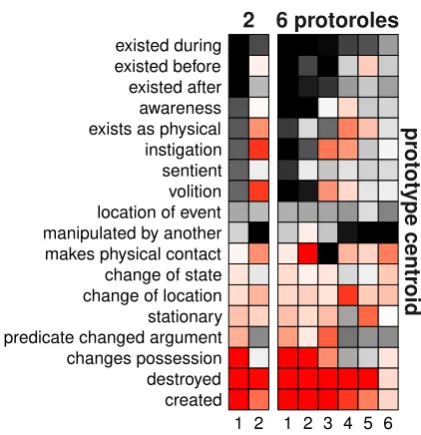The Semantic Proto-Role Linking Model
Aaron Steven White Science of Learning Institute
Johns Hopkins University aswhite@jhu.edu
Kyle Rawlins Cognitive Science Johns Hopkins University
kgr@jhu.edu
Benjamin Van Durme Computer Science Johns Hopkins University vandurme@cs.jhu.edu
Abstract
We propose the semantic proto-role linking model, which jointly induces both predicate-specific semantic roles and predicate-general semantic proto-roles
based on semantic proto-role property likelihood judgments. We use this model to empirically evaluate Dowty’s thematic proto-role linking theory.
1 Introduction
A linking theory explains how predicates’ se-mantic arguments—e.g. HITTER, HITTEE, and HITTING-INSTRUMENT for hit—are mapped to
theirsyntactic arguments—e.g. subject, direct ob-ject, or prepositional object (see Fillmore 1970; Zwicky 1971; Jackendoff 1972; Carter 1976; Pinker 1989; Grimshaw 1990; Levin 1993). (1) a. [John]HITTERhit [the fence]HITTEE.
b. [The stick]INSThit [the fence]HITTEE.
A semantic role labeling (SRL) system imple-ments the inverse of a linking theory: where a linking theory maps a predicate’s observed seman-tic arguments to its latent syntacseman-tic arguments, an SRL system maps a predicate’s observed syntac-tic arguments to its latent semansyntac-tic arguments (see Gildea and Jurafsky 2002; Litkowski 2004; Car-reras and Marquez 2004; Marquez et al. 2008).
SRL is generally treated as a supervised task— requiring semantic role annotation, which is ex-pensive, time-consuming, and hard to scale. This has led to the development of unsupervised sys-tems forsemantic role induction(SRI), which in-duce predicate-specific roles—cf. PropBank roles (Palmer et al., 2005)—from syntactic and lexical features of a predicate and its arguments.
One approach to SRI that has proven fruitful is to explicitly implement linking as a
compo-nent of generative (cf. Grenager and Manning, 2006) or discriminative (cf. Lang and Lapata, 2010) models. But while most SRI systems have some method for generalizing across specific roles, few explicitly induce predicate-general roles—cf. VerbNet roles (Kipper-Schuler, 2005)—separately from predicate-specific roles. This is a missed opportunity, since the nature of such roles is a contentious topic in the theoreti-cal literature, and the SRI task seems likely to be useful for approaching questions about them in an empirically rigorous way.
We focus in particular on empirically assess-ing the semantic proto-role theory developed by Dowty (1991). We propose the semantic proto-role linking model (SPROLIM), which jointly
in-duces both specific roles and predicate-generalsemantic proto-roles(Dowty, 1991) based on semantic proto-role property likelihood judg-ments (Reisinger et al., 2015; White et al., 2016).
We apply SPROLIM to Reisinger et al.’s
proto-role property annotations of PropBank. To evaluate SPROLIM’s ability to recover
predicate-specific roles, we compare the predicate-predicate-specific roles it induces against PropBank, finding that
SPROLIM outperforms baselines that do not
dis-tinguish predicate-specific and predicate-general roles. We then compare the predicate-general roles that SPROLIM induces against those Dowty
proposes, finding a predicate-general role that matches Dowty’s PROTOAGENT. Finally, our
work could be viewed as an approach to associat-ing a vector-space semantics to the categorical la-bels of existing type-level semantic role resources, and so we release a resource that maps from Prop-Bank roles to semantic vectors as fit bySPROLIM. 2 Related work
Prior work in SRI has tended to focus on using syntactic and lexical features to cluster arguments
l a
θ z
s ψ
c
φ
η µ
κ
δ
Tvj
S S R
P
j∈ Cv
Av |Av|
[image:2.595.91.268.60.263.2]v∈ V
Figure 1:Plate diagram forSPROLIM
into semantic roles. Swier and Stevenson (2004) introduce the first such system, which uses a boot-strapping procedure to first associate verb tokens with frames containing typed slots (drawn from VerbNet), then iteratively compute probabilities based on cooccurrence counts and fill unfilled slots based on these probabilities.
Grenager and Manning (2006) introduce the idea of generating syntactic position based on a latent semantic role representation learned from syntactic and selectional features. Lang and La-pata (2010) expand on Grenager and Manning (2006) by introducing the notion of a canonical-ized linking. The idea behind canonicalization is to account for the fact that the syntactic argument that a particular semantic argument is mapped to can change depending on the syntax. For instance, when hit is passivized, the HITTEE argument is
mapped to subject position, where it would nor-mally be mapped to object position.
(2) [The fence]HITTEEwas hit.
We incorporate both ideas into our Semantic Proto-Role Linking Model (SPROLIM).
SRI approaches that do not explicitly incorpo-rate the idea of a linking theory have also been popular. Lang and Lapata (2011a, 2014) use graph clustering methods and Lang and Lapata (2011b) use a split-merge algorithm to cluster arguments based on syntactic context. Titov and Klementiev (2011) use a non-parametric clustering method based on the Pitman-Yor Process, and Titov and Klementiev (2012) propose nonparametric
cluster-Algorithm 1Semantic Proto-Role Linking Model
1: forverb typev∈ Vdo
2: forargument typei∈ Avdo
3: drawsemantic protorolezvi∼Cat(θvi)
4: forverb tokenj∈ Cvdo
5: drawcanonicalizationk∼Cat(φv|Tvj|)
6: cvj←element of symmetric groupS|Tvj|,k
7: letr:|Tvj|-length tuple
8: forargument tokent∈ Tvjdo
9: rt←semantic protorolezvcvjt
10: forpropertyp∈ Pdo
11: drawavjt∼Bern(ηrvjtp)
12: ifavjt= 1then
13: drawlvjt∼Cat(Ordκ(µrtp))
14: letρ:|S|Tvj||-length vector
15: forlinkings0∈ S|Tvj|do
16: ρs0 ←Qtsoftmax
ψrt+Po6=tδs0
ts0o
17: drawlinkingk∼Cat(ρ)
18: svj← Sk|Tvj|
ing models based on the Chinese Restaurant Pro-cess (CRP) and distance dependent CRP.
While each of these SRI systems have some method for generalizing across predicate-specific roles, few induce explicit predicate-general roles, like AGENT and PATIENT, separately from
predicate-specific roles. One obstacle is that there is no agreed upon set of roles in the theoretical literature, making empirical evaluation difficult. One reason that such a set does not exist is that reasonably wide-coverage linking theories require an ever-growing number of roles to capture linking regularities—a problem that Dowty (1991) refers to asrole fragmentation(see also Dowty, 1989).
As a solution to role fragmentation, Dowty proposes the proto-role linking theory (PRLT). Instead of relying on categorical roles, such as
AGENTandPATIENT—like traditional linking
the-ories do—PRLT employs a small set of relational properties (e.g. volition, instigation, change of state, etc.) that a predicate can entail about its ar-guments. Dowty partitions these relational prop-erties into two sets, indexed by two proto-roles:
PROTOAGENT and PROTOPATIENT. The
syntac-tic position that a parsyntac-ticular predicate-specific role is mapped to is then determined by how many properties from each set hold of arguments that fill that role. The reason PROTOAGENTandPRO -TOPATIENT are known asproto-roles is that they
amount to role prototypes (Rosch and Mervis, 1975): a particular predicate-specific role can be closer or further from a PROTOAGENT or PRO -TOPATIENTdepending on its properties.
annota-svj1 svj2
svj3
zvcvj1
zvcvj2
[image:3.595.85.274.61.198.2]zvcvj3
Figure 2:Linking model factor graph for tokenjof predi-catevwith three arguments.
tions of Dowty’s proto-role properties by gather-ing answers to simple questions about how likely, on a five-point scale, it is that particular relational properties hold of arguments in PropBank (cf. Kako, 2006; Greene and Resnik, 2009; Hartshorne et al., 2013). We use these annotations, known as SPR1 (White et al., 2016), to train our semantic proto-role linking model(SPROLIM).1
3 Semantic Proto-Role Linking Model SPROLIMimplements a generalization of Dowty’s
semantic proto-role linking theory that allows for any number of proto-roles—i.e. predicate-general roles. Figure 1 shows a plate diagram for the full model, and Algorithm 1 gives its generative story. There are two main components of SPROLIM: (i)
theproperty modeland (ii) themapping model. Property model The property model relates each predicate-general role—i.e. proto-role—to (i) the likelihood that a property is applicable to an argument with that role and, (ii) if applicable, how likely it is the property holds of that argument.
We implement this model using a cumulative link logit hurdle model (see Agresti, 2014). In this model, each semantic proto-roler ∈ Ris associ-ated with two|P|-length real-valued vectors: ηr,
which gives the probability that each propertypis applicable to an argument that has roler, andµr,
which corresponds to the likelihood of each prop-ertyp∈ P when an argument has roler.
In the hurdle portion of the model, a Bernoulli probability mass function for applicability a ∈ {0,1}is given byP(a|η) =ηa(1−η)1−a. What
makes this a hurdle model is that the rating prob-ability only kicks in if the rating crosses the ap-plicability “hurdle” (cf. Mullahy, 1986). The
pro-1SPR1 is available athttp://decomp.net.
cedural way of thinking about this is that, first, a rater decides whether a property is applicable; if it is not, they stop; if it is, they generate a rating. The joint probability oflandais then defined as
P(l, a|µ, η,κ)∝P(a|η)P(l|µ,κ)a
In the cumulative link logit portion of the model, a categorical probability mass function with support on the property likelihood ratingsl ∈ {1, . . . ,5} is determined by a latent µ and a nondecreasing real-valued cutpoint vectorκ.
P(l=j|µ,κ) = (
1−qj−1 ifj= 5
qj−qj−1 otherwise
where qj ≡ logit−1(κj+1 −µ) and q0 ≡ 0. In
Algorithm 1, we denote the parameters of this dis-tribution as Ordκ(µ).
Mapping model The mapping model has two components: (i) the canonicalizer, which maps from argument tokens to predicate-specific roles, and (ii) the linking model, which maps from predicate-specific roles to syntactic positions.
We implement the canonicalizer by assuming that, for each predicate (verb) v, there is some canonical ordering of its predicate-specific roles and that for each sentence (clause) j ∈ Cv that
voccurs in, there is some permutation ofv’s argu-ment tokens in that sentence that aligns them with their predicate-specific role in the canonical order. Denoting the set of argument tokens in sentencej withTvj, the set of possible mappings is the
sym-metric groupS|Tvj|. We place a categorical
distri-bution with parameterφvon this group.
We implement the linking model using the con-ditional random field whose factor graph is de-picted in Figure 2. This diagram corresponds to thesnode and all of its parents in Figure 1.
4 Experiments
In this experiment, we fit SPROLIM to the SPR1
data and investigate the predicate-specific and predicate-general roles it learns.2
Baseline models We use two kinds of Gaus-sian Mixture Models (GMMs) as baselines: one that uses only the property judgments associated with each argument and another that uses both 2All code, along with the learned predicate and role
0.75 0.80 0.85 0.90 0.95
2 3 4 5 6 7
Number of roles
Cluster pur
ity
Baseline (sem only) Baseline (sem + syn) SPROLIM
macroaverage microaverage
Figure 3: Cluster purity for predicate-specific roles with baselines andSPROLIM.
those property judgments and the syntactic posi-tion. We treat each GMM component as a seman-tic role, extracting each argument’s role by taking the maximum over that argument’s mixture distri-bution. Since there is no principled distinctions among GMM components, these baselines imple-ment systems that does not distinguish between predicate-specific and predicate-general roles.
Model fitting To fitSPROLIM, we use projected
gradient descent with AdaGrad (Duchi et al., 2011) to find an approximation to the maximum likelihood estimates forΘ,Φ,M,E,Ψ,∆, and
κ, with the categorical variables Z and C inte-grated out of the likelihood. To fit the GMM base-lines, we use Expectation Maximization.
Results Following Lang and Lapata (2010) and others, we evaluate the model using cluster purity.
purity(C, T) =
|C|
X
i
1
|ci|maxj |ci∩tj|
whereC={ci}is the partition of a predicate’s
ar-guments given by a model, andT ={tj}is some
ground truth partition—here, PropBank roles. Figure 3 shows the micro- and macro-average cluster purity for both the GMM baselines and
SPROLIM fit with differing numbers of semantic
roles. We see that even with only two predicate-general proto-roles,SPROLIM is better able to
as-sign correct predicate-specific roles than the two baseline GMMs. SPROLIM reaches maximum
[image:4.595.76.277.62.259.2]cluster purity at six proto-roles.
Figure 4 shows the estimates of the property likelihood centroidsLfor|R| ∈ {2, 6}. Columns give the prototype centroid for a single proto-role. At |R| = 2, the first proto-role centroid corre-sponds nearly perfectly to the PROTOAGENT role
proposed by Dowty. Furthermore, by inspect-ing the role-syntax associations Ψ, we see that this proto-role is more strongly associated with the subject position than proto-role 2, and so we henceforth refer to it as thePROTOAGENTrole.
A proto-role analogous to the PROTOAGENT
role is found for all other values of|R|that we fit. For instance, at|R| = 6, the first proto-role cen-troid is highly correlated with the first proto-role centroid at|R|= 2. The only difference between this centroid and the one found at|R|= 2 is that the one at|R|= 6 loads even more positively on Dowty’s proto-agent properties.
At |R| = 6, the second proto-role centroid ap-pears to be a modified version of the PROTOA -GENT role that does not require physical
exis-tence or sentience and is negatively associated with physical contact. By investigating the proto-role mixtures Θ for each argument, we see that this captures cases of nonsentient or abstract—but still agentive—subjects—e.g.Mobilin (3).
(3) Mobil restructuredthe entire company dur-ing an industrywide shakeout.
The rest of the roles are more varied. For |R|= 2, the second proto-role centroid loads negatively (or near zero) on allPROTOAGENTproperties, and
really, all other properties besidesMANIPULATED BY ANOTHER. This non-PROTOAGENT role
ap-pears to split into four separate roles at|R| = 6, three of which load heavily onmanipulated by an-other (proto-roles 4-6) and the fourth of which (proto-role 3) requires makes physical contact. Each of these four non-PROTOAGENTroles might
be considered to be different flavors ofPROTOPA -TIENT, which does not appear to be a unified
con-cept. This is corroborated by examples of argu-ments that load on each of these four proto-roles.
For instance, the objects ofsign,want, and di-vertload heavily on the third proto-role.
(4) a. President Bushsigneda disaster decla-rationcovering seven CA counties. b. The U.S. wantsa higher won to make
c. They divert law-enforcement resources
at a time they are most needed for pro-tecting lives and property.
The subjects of verbs likedate,stem, andrecover
(in their intransitive form) load heavily on the fourth proto-role.
(5) a. His interest in the natural environment
datesfrom his youth.
b. Most of the telephone problems
stemmedfrom congestion.
c. Junk bonds also recovered somewhat, though trading remained stalled.
The objects of verbs likereduce,lower, andslash
load heavily on the fifth proto-role.
(6) a. The firm reduced those stock holdings
to about 70%.
b. It alsoloweredsome air fares.
c. Robertson Stephensslashedthe value of the offeringby 7%.
And the objects of verbs likegain,lose, anddrop, which tend to involve measurements, load heavily on the sixth proto-role.
(7) a. Fujisawagained50to 2,060. b. A&W Brandslost1/4to 27 .
c. B.F. Goodrichdropped1 3/8to 49 1/8 .
This last category is interesting because it raises a question about how sensitiveSPROLIMis to the
particular domain on which the proto-role prop-erties are annotated. For instance, outside of newswire, the senses of the verbs in (7) are less likely to include measure arguments, and so per-hapsSPROLIMwould not find such a proto-role in
annotations of text from a different genre.
We believe this warrants further investigation. But we also note that (7) does not exhaust the kinds of arguments that load heavily on the sixth proto-role: the objects of consume and borrow
(among many others) also do so.
(8) a. In fact, fewconsumemuch of anything. b. All they are trying to do isborrowsome
of the legitimacy of the Bill of Rights.
The fact that the arguments in (8) are at least su-perficially unlike the measure arguments found in (7) may suggest thatSPROLIM is discovering that
measure arguments such as those in (7) fall into a
2 6 protoroles
created destroyed changes possession predicate changed argument stationary change of location change of state makes physical contact manipulated by another location of event volition sentient instigation exists as physical awareness existed after existed before existed during
pr
ototype centr
oid
[image:5.595.308.519.62.280.2]1 2 1 2 3 4 5 6
Figure 4:Heatmap of prototype centroids for property like-lihood ratings for models with 2 proto-roles and 6 proto-roles. Black is+and red is−.
larger category, in spite of genre-related biases.
5 Conclusion
In this paper, we proposed the semantic proto-role linking model, which jointly induces both specific semantic roles and predicate-general semantic proto-roles based on semantic proto-role property likelihood judgments. We used this model to empirically evaluate Dowty’s thematic proto-role linking theory, confirming the existence of Dowty’sPROTOAGENTrole but
find-ing evidence that his PROTOPATIENT role may
consist of at least four subtypes.
We have three aims for future work: (i) to as-sess how robust the proto-roles we induce here are to genre effects; (ii) to assess whether languages differ in the set of proto-roles they utilize; and (iii) to extend this model to incorporate annota-tions that semantically decompose noun meanings and verb meanings in theoretically motivated ways (cf. White et al., 2016).
Acknowledgments
References
Alan Agresti. Categorical Data Analysis. John Wiley & Sons, 2014. ISBN 1-118-71085-1. Xavier Carreras and Llus Marquez.
Introduc-tion to the CoNLL-2004 shared task: Seman-tic role labeling. In Proceedings of the Ninth Conference on Computational Natural Lan-guage Learning, pages 152–164. Association for Computational Linguistics, 2004.
Richard Carter. Some linking regularities. InOn Linking: Papers by Richard Carter, Lexicon Project Working Papers (Vol. 25). MIT Center for Cognitive Science, Cambridge, MA, 1976. David Dowty. Thematic proto-roles and argument
selection. Language, 67(3):547–619, 1991. David R. Dowty. On the semantic content of the
notion of thematic role. InProperties, types and meaning, pages 69–129. Springer, 1989. John Duchi, Elad Hazan, and Yoram Singer.
Adaptive subgradient methods for online learn-ing and stochastic optimization. The Journal of Machine Learning Research, 12:2121–2159, 2011.
Charles John Fillmore. The grammar of hitting and breaking. In R.A. Jacobs and P.S. Rosen-baum, editors, Readings in English Trans-formational Grammar, pages 120–133. Ginn, Waltham, MA, 1970.
Daniel Gildea and Daniel Jurafsky. Automatic la-beling of semantic roles. Computational Lin-guistics, 28(3):245–288, 2002.
Stephan Greene and Philip Resnik. More than words: Syntactic packaging and implicit sen-timent. In Proceedings of Human Language Technologies: The 2009 Annual Conference of the North American Chapter of the Associa-tion for ComputaAssocia-tional Linguistics, pages 503– 511. Association for Computational Linguis-tics, 2009. ISBN 1-932432-41-8.
Trond Grenager and Christopher D. Manning. Un-supervised discovery of a statistical verb lexi-con. InProceedings of the 2006 Conference on Empirical Methods in Natural Language Pro-cessing, pages 1–8. Association for Computa-tional Linguistics, 2006. ISBN 1-932432-73-6. Jane Grimshaw. Argument structure. MIT Press,
Cambridge, MA, 1990. ISBN 0262071258.
Joshua K. Hartshorne, Claire Bonial, and Martha Palmer. The VerbCorner Project: Toward an Empirically-Based Semantic Decomposition of Verbs. In Proceedings of the 2013 Confer-ence on Empirical Methods in Natural Lan-guage Processing, pages 1438–1442, 2013. Ray Jackendoff. Semantic Interpretation in
Gen-erative Grammar. MIT Press, Cambridge, MA, 1972. ISBN 0-262-10013-4.
Edward Kako. Thematic role properties of sub-jects and obsub-jects. Cognition, 101(1):1–42, 2006.
Karin Kipper-Schuler. VerbNet: A broad-coverage, comprehensive verb lexicon. PhD thesis, University of Pennsylvania, 2005. Joel Lang and Mirella Lapata. Unsupervised
in-duction of semantic roles. In Human Lan-guage Technologies: The 2010 Annual Confer-ence of the North American Chapter of the As-sociation for Computational Linguistics, pages 939–947. Association for Computational Lin-guistics, 2010. ISBN 1-932432-65-5.
Joel Lang and Mirella Lapata. Unsupervised se-mantic role induction with graph partitioning. In Proceedings of the Conference on Empiri-cal Methods in Natural Language Processing, pages 1320–1331. Association for Computa-tional Linguistics, 2011a. ISBN 1-937284-11-5. Joel Lang and Mirella Lapata. Unsupervised se-mantic role induction via split-merge cluster-ing. In Proceedings of the 49th Annual Meet-ing of the Association for Computational Lin-guistics: Human Language Technologies, vol-ume 1, pages 1117–1126. Association for Com-putational Linguistics, 2011b. ISBN 1-932432-87-6.
Joel Lang and Mirella Lapata. Similarity-driven semantic role induction via graph partition-ing.Computational Linguistics, 40(3):633–669, 2014.
Beth Levin. English verb classes and alterna-tions: A preliminary investigation. University of Chicago Press, 1993. ISBN 0226475336. Ken Litkowski. Senseval-3 task: Automatic
Lluis Marquez, Xavier Carreras, Kenneth C. Litkowski, and Suzanne Stevenson. Semantic role labeling: an introduction to the special is-sue. Computational linguistics, 34(2):145–159, 2008.
John Mullahy. Specification and testing of some modified count data models. Journal of econo-metrics, 33(3):341–365, 1986.
Martha Palmer, Daniel Gildea, and Paul Kings-bury. The proposition bank: An annotated cor-pus of semantic roles. Computational Linguis-tics, 31(1):71–106, 2005.
Steven Pinker. Learnability and Cognition: The Acquisition of Argument Structure. MIT Press, Cambridge, MA, 1989. ISBN 0-262-51840-6. Drew Reisinger, Rachel Rudinger, Francis
Fer-raro, Craig Harman, Kyle Rawlins, and Ben-jamin Van Durme. Semantic Proto-Roles.
Transactions of the Association for Computa-tional Linguistics, 3:475–488, 2015.
Eleanor Rosch and Carolyn B. Mervis. Family resemblances: Studies in the internal structure of categories. Cognitive psychology, 7(4):573– 605, 1975.
Robert S. Swier and Suzanne Stevenson. Unsuper-vised semantic role labelling. InProceedings of EMNLP, volume 95, page 102, 2004.
Ivan Titov and Alexandre Klementiev. A Bayesian model for unsupervised semantic parsing. In
Proceedings of the 49th Annual Meeting of the Association for Computational Linguis-tics: Human Language Technologies, volume 1, pages 1445–1455. Association for Computa-tional Linguistics, 2011. ISBN 1-932432-87-6. Ivan Titov and Alexandre Klementiev. Crosslin-gual induction of semantic roles. In Proceed-ings of the 50th Annual Meeting of the Associ-ation for ComputAssoci-ational Linguistics: Long Pa-pers, volume 1, pages 647–656. Association for Computational Linguistics, 2012.
Aaron Steven White, Drew Reisinger, Keisuke Sakaguchi, Tim Vieira, Sheng Zhang, Rachel Rudinger, Kyle Rawlins, and Benjamin Van Durme. Universal decompositional seman-tics on universal dependencies. InProceedings of the 2016 Conference on Empirical Meth-ods in Natural Language Processing, pages 1713–1723, Austin, TX, 2016. Association for Computational Linguistics.



